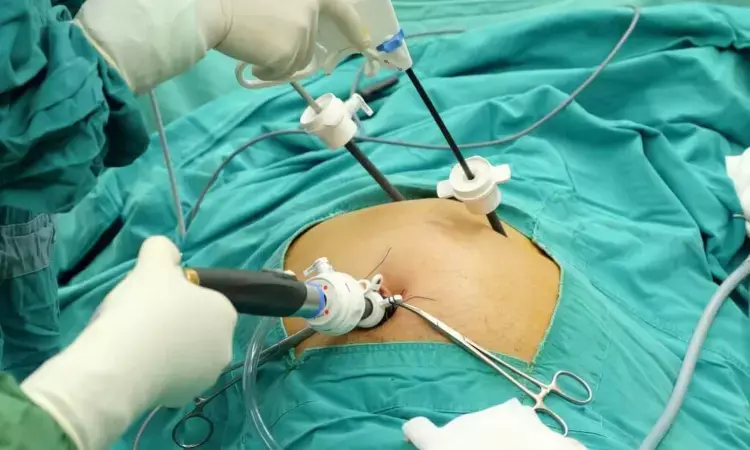- Home
- Medical news & Guidelines
- Anesthesiology
- Cardiology and CTVS
- Critical Care
- Dentistry
- Dermatology
- Diabetes and Endocrinology
- ENT
- Gastroenterology
- Medicine
- Nephrology
- Neurology
- Obstretics-Gynaecology
- Oncology
- Ophthalmology
- Orthopaedics
- Pediatrics-Neonatology
- Psychiatry
- Pulmonology
- Radiology
- Surgery
- Urology
- Laboratory Medicine
- Diet
- Nursing
- Paramedical
- Physiotherapy
- Health news
- Fact Check
- Bone Health Fact Check
- Brain Health Fact Check
- Cancer Related Fact Check
- Child Care Fact Check
- Dental and oral health fact check
- Diabetes and metabolic health fact check
- Diet and Nutrition Fact Check
- Eye and ENT Care Fact Check
- Fitness fact check
- Gut health fact check
- Heart health fact check
- Kidney health fact check
- Medical education fact check
- Men's health fact check
- Respiratory fact check
- Skin and hair care fact check
- Vaccine and Immunization fact check
- Women's health fact check
- AYUSH
- State News
- Andaman and Nicobar Islands
- Andhra Pradesh
- Arunachal Pradesh
- Assam
- Bihar
- Chandigarh
- Chattisgarh
- Dadra and Nagar Haveli
- Daman and Diu
- Delhi
- Goa
- Gujarat
- Haryana
- Himachal Pradesh
- Jammu & Kashmir
- Jharkhand
- Karnataka
- Kerala
- Ladakh
- Lakshadweep
- Madhya Pradesh
- Maharashtra
- Manipur
- Meghalaya
- Mizoram
- Nagaland
- Odisha
- Puducherry
- Punjab
- Rajasthan
- Sikkim
- Tamil Nadu
- Telangana
- Tripura
- Uttar Pradesh
- Uttrakhand
- West Bengal
- Medical Education
- Industry
Robotic vs. Laparoscopic Cholecystectomy: Study finds No Clear Advantage for Robotic Approach

Researchers have found in a large, propensity-matched cohort study of acute care cholecystectomy cases, that both robotic-assisted and laparoscopic techniques showed similar bile duct injury rates. However, robotic-assisted cholecystectomy was linked to higher postoperative complications, longer hospital stays, and increased drain usage. These results indicate that, under current conditions, robotic-assisted cholecystectomy may not provide clear benefits over the standard laparoscopic method, highlighting the need for further research to optimize its use.
The study was published in JAMA Surgery by Nathnael A. and fellow researchers. This retrospective cohort analysis compared information loss from 844,428 adult patients undergoing cholecystectomy in an acute care environment during 2016-2021. Patients were sampled from a U.S. commercial encounter and loss-adjusted claims database. Propensity scoring was employed by researchers to match 35,037 robotic-assisted cholecystectomy with 35,037 laparoscopic cholecystectomy cases, balancing clinical factors for equitable comparison. Data analysis was performed in 2024.
The primary outcome was bile duct injury, a severe complication that may cause considerable morbidity. Secondary outcomes comprised postoperative complications, hospital stay, and postoperative drain use.
Key Findings
The study revealed no significant difference in bile duct injury rates between the two surgical methods:
• Bile duct injury occurred in 0.37% (128 of 35,037) of robotic-assisted cases vs 0.39% (138 of 35,037) of laparoscopic cases
• Odds Ratio (OR): 0.93
• 95% Confidence Interval (CI): 0.73–1.18
• P = 0.54 (not statistically significant)
However, robotic-assisted cholecystectomy was associated with worse outcomes in several other important measures:
• Major postoperative complications were significantly higher:
• 8.37% (2,934 of 35,037) in the robotic group vs 5.50% (1,926 of 35,037) in the laparoscopic group
• OR: 1.57; 95% CI: 1.48–1.67; P < 0.001
Postoperative drain use was also greater with robotic surgery:
• 0.63% (219 of 35,037) vs 0.48% (132 of 35,037)
• OR: 1.66; 95% CI: 1.34–2.07; P < 0.001
• Median hospital stay was longer for robotic patients:
• 3 days (interquartile range [IQR]: 2–4) vs 2 days (IQR: 1–4); P < 0.001
Robotic-assisted and laparoscopic cholecystectomy were shown to have equivalent bile duct injury rates in acute care surgery. Robotic-assisted surgery, however, had greater complication rates, longer lengths of stay, and more drainage use. These results indicate that, in its current state of development and use, robotic-assisted cholecystectomy does not have a clear benefit over conventional laparoscopic techniques.
Reference:
Dr Riya Dave has completed dentistry from Gujarat University in 2022. She is a dentist and accomplished medical and scientific writer known for her commitment to bridging the gap between clinical expertise and accessible healthcare information. She has been actively involved in writing blogs related to health and wellness.
Dr Kamal Kant Kohli-MBBS, DTCD- a chest specialist with more than 30 years of practice and a flair for writing clinical articles, Dr Kamal Kant Kohli joined Medical Dialogues as a Chief Editor of Medical News. Besides writing articles, as an editor, he proofreads and verifies all the medical content published on Medical Dialogues including those coming from journals, studies,medical conferences,guidelines etc. Email: drkohli@medicaldialogues.in. Contact no. 011-43720751


